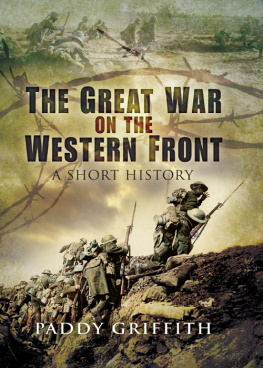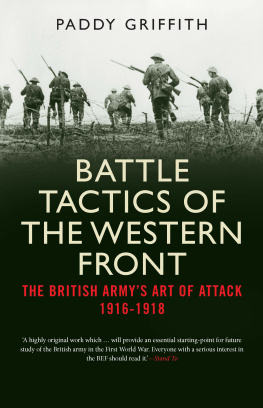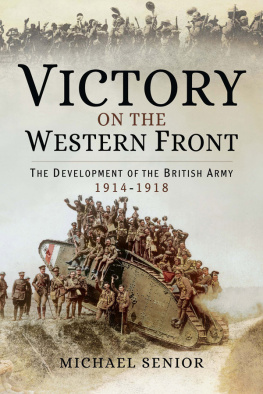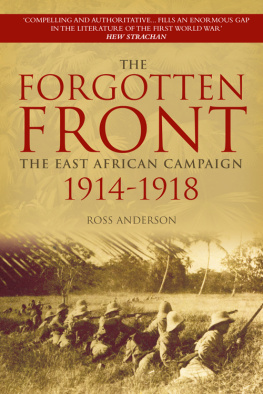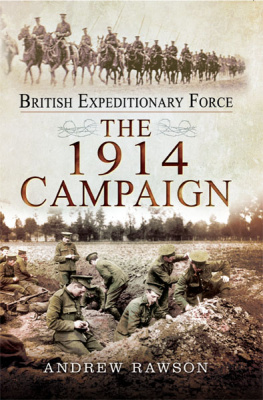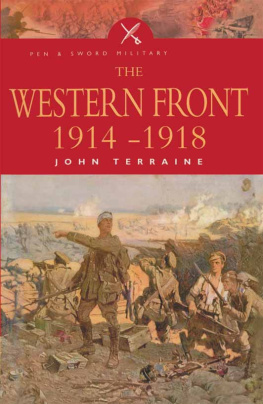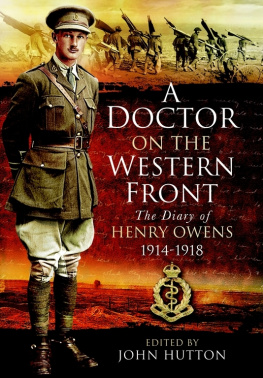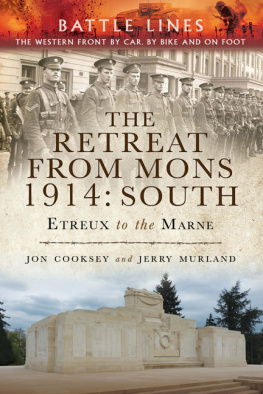First published in Great Britain in 2008 by
PEN & SWORD MILITARY
an imprint of
Pen & Sword Books Ltd
47 Church Street
Barnsley
South Yorkshire
S70 2AS
Copyright Paddy Griffith, 2008
ISBN 978-1-84415-764-8
eISBN 978-1-84468-931-6
PRC ISBN 978-1-84468-932-3
The right of Paddy Griffith to be identified as Author of this Work has been asserted by him in accordance with the Copyright, Designs and Patents Act 1988.
A CIP catalogue record for this book is available from the British Library.
All rights reserved. No part of this book may be reproduced or transmitted in any form or by any means, electronic or mechanical including photocopying, recording or by any information storage and retrieval system, without permission from the Publisher in writing.
Typeset by Concept, Huddersfield, West Yorkshire
Printed and bound in Great Britain by Biddles Ltd
Pen & Sword Books Ltd incorporates the imprints of Pen & Sword Aviation, Pen & Sword Maritime, Pen & Sword Military, Wharncliffe Local History, Pen & Sword Select, Pen & Sword Military Classics and Leo Cooper.
For a complete list of Pen & Sword titles please contact PEN & SWORD BOOKS LIMITED 47 Church Street, Barnsley, South Yorkshire, S70 2AS, England.
E-mail:
Website: www.pen-and-sword.co.uk
Contents
List of Maps and Illustrations
List of Plates
Acknowledgements
Illustrations have been supplied by the Taylor Library, Barnsley, unless otherwise acknowledged. I am grateful to Ed Dovey for drawing the maps on pp. 14 and 89.
Preface
Very many large, laudable and learned books have been written about the Western Front, but there are not nearly as many of them as there are sensationalist and subjective ones. The present volume hopes to fall into neither of those two categories, but to present a short and compact overview that is accessible to the general reader, and which may serve as a springboard for further reading. It is also intended to offer a mainly military explanation of what happened, including the place of the Western Front in the general history of the art of war. This means that on one hand we will not look closely at the higher diplomacy, politics and strategy of the war as a whole, nor at the evolution of other fronts. On the other hand we will leave to others the task of interpreting the horrors, the traumas and the poetry of trench life.
My narrative deals mainly with the English-speaking armies on the Western Front the British, Australians, Canadians, New Zealanders, South Africans and Americans although I hope that the Germans and French will not be relegated to the status merely of walk-on parts. Obviously during the period before 1 July 1916 it was those two nations which fought by far the major part of the war in the West, and they continued to fight many major battles with each other, without large-scale Anglo-Saxon intervention, right up to the very end. Nevertheless it remains true that the war entered a very different phase when the British New Armies entered the fray in force on the Somme in the summer of 1916. Both the modernity and the intensity of the fighting would grow inexorably during the next two years, as the allies became stronger and the Germans gradually wilted. There would be setbacks along the way, notably the German spring offensives of 1918, but it was clear that France no longer stood alone, and would eventually clear the invader out of her lands.
Paddy Griffith
Withington, May 2007
CHAPTER ONE
The Start of the War and of the Western Front
THE START OF THE WAR
It would be a grotesque understatement to say that the First World War represented a major turning point in history. Four great empires were brought down by it the German, Russian, Austro-Hungarian and Ottoman empires while those that remained were battered beyond recognition. An array of awesome new weaponry, mass-produced on an industrial scale, killed over 10 million people within the space of four years, quite apart from what must have amounted to some 20 million maimed and injured, and doubtless even more. Nor could the damage be limited merely to that, because the botched peace treaties of 1919 would lead on to a second and still worse world war just twenty years later, which would kill over 60 million.
At least the rights and wrongs of the Second World War would be relatively straightforward and easy to understand. With the First (or Great) War this is considerably less easy to say. It has a reputation as a futile war which began for no particularly good reason, and continued with shifting and ambiguous objectives for each combatant nation. There were no great ideologies in conflict, such as Fascism versus Communism or Democracy versus Dictatorship, but only a set of squabbling old-fashioned imperialisms and nationalisms which to the modern outsider do not seem to have been worth the gigantic price that was paid to sustain them. To the modern eye it seems that the inefficient monarchies and incomplete democracies of 1914 marched off to war far too readily, blindly following long-ingrained habits whereby the impoverished and deferential masses would spring to arms enthusiastically, whenever the emperors and their general staffs chose to click their fingers.
However, if viewed in a different light we can see that the real issue at stake was whether or not Germany should be allowed to impose hegemony over the whole of continental Europe, and thereby emerge as the first true superpower in the global arena. In 1914 Germany was already the strongest military power in the world, and stopping her would inevitably be a titanic undertaking. Not even the whole Entente Cordiale of France, Russia, Britain and eventually Italy possessed adequate military power to have any realistic hope of a quick and easy victory, although unrealistic hopes of one were widespread. Quite apart from the revolution in weaponry that made life on the battlefields very different from what the generals had been expecting, the Germans could also counterbalance the Entente with allies of their own: initially the Austro-Hungarian empire, and later Turkey.
Within this gigantic conflict it soon became clear that the most advanced and concentrated form of warfare was mainly centred on the Western front in Belgium and northern France. In strategic terms this was the key to the whole of western Europe, while in military terms it was always the decisive theatre. It was the scene of the main German assault in August 1914 and then, when the Germans reverted to the defensive in the West, it remained their centre of gravity. Their main army remained in place there, and was hard pressed to contain repeated large offensives by the two most technologically advanced members of the Entente. If the German gains could not be reversed here, they could not be reversed anywhere.
But why did the war break out at all? Some commentators like to make rather airy and intangible generalizations about the rigid stratification of social classes at the time, combined with a traditional view of war almost as the sport of kings. More credibly, we should recognize the importance of another and harder-edged type of logic, based on realpolitik and the iron necessities of national survival. In particular we can point to the system of opposing alliances by which the European balance of power had been maintained for many decades, but with accelerating intensity since the establishment of the German empire in 1871. By 1907 Britain had joined the Entente Cordiale with France and Russia, as a power bloc facing the Central Powers of Germany and Austro-Hungary. Several different arms races were run between the two sides; not only to build bigger armies and navies, but also in terms of metallurgical and chemical industries, in the building of fortifications and in the acquisition of colonies. Each of these separate arms races had its own pace and dynamic, and could lead to widely different results. For example, a colonial confrontation such as that between Britain and France at Fashoda in 1898, or between France and Germany at Agadir in 1911, could bring tensions to a head and so help to produce a local diplomatic settlement. On the other hand, sabre-rattling might easily have a distinctly destabilizing effect. Most notably, the French law of 7 August 1913 to increase the size of the army by extending the period of conscription to three years led the German General Staff to calculate that it would be advantageous for them to force a showdown with France sooner rather than later. According to this analysis the almost mathematical result was a war that started in August 1914.
Next page
